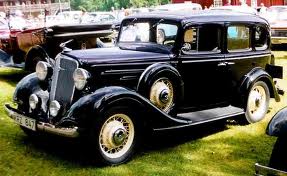'35 Chevy
No one is interested in this but me, but then this is my blog, SWC. Weldon: I miss Weldon. I really miss Weldon Faul. Weldon loved to come back at me with conversation when he would discover that we had bits of history in common or contrast, not only the Episcopal Church, but interest in cars. Weldon had a childhood history from northern Michigan, bitter cold winters and poverty when he was afraid to go home because of having ruined a rare and precious new pair of shoes that his parent had saved up for and there was no replacing them. Weldon was a retired GM plant manager, a history that caused me envy. He picked up on two cars that crossed in our history, black 1935 Chevrolet coaches (two door sedans) and dark green 1948 Dodge Custom sedans.
Soon after they were married in 1934, my parents bought a new 1935 Chevrolet Master coach:
My father’s car before that had been, to my best recollection, a 1931 Chevrolet coupe. But they lived here in St. Andrews and my mother’s family were in Pensacola, and they needed a car that could make the round trip reliably and safely. My father bought Chevys only, from his friend and Bay Hi classmate Bubber Nelson. For 1935, Chevrolet offered two lines, the Standard and the Master, not simply two trim lines, but two completely different automobile designs. The Standard was a continuation from old design, square body tucked slightly in at the rear, with fabric roof covering wooden slats. Slow but soon enough, the fabric top deteriorated and began to leak, and with water came wood and fabric rot. 1935 Standard coach:
My father’s car before that had been, to my best recollection, a 1931 Chevrolet coupe. But they lived here in St. Andrews and my mother’s family were in Pensacola, and they needed a car that could make the round trip reliably and safely. My father bought Chevys only, from his friend and Bay Hi classmate Bubber Nelson. For 1935, Chevrolet offered two lines, the Standard and the Master, not simply two trim lines, but two completely different automobile designs. The Standard was a continuation from old design, square body tucked slightly in at the rear, with fabric roof covering wooden slats. Slow but soon enough, the fabric top deteriorated and began to leak, and with water came wood and fabric rot. 1935 Standard coach:
The 1935 Master was a completely new design, a somewhat bulbous looking body for the day, but streamlined in shape, and all metal roof, no more fabric, GM called it a “turret” body. For the 1935 Master only, the Chevrolet had forward opening “suicide” doors. Why that body style came and went so quickly escapes me, except that my mother told me many years ago that it was awkward getting in and out, especially if parked in close quarters; and that the people in the back seat of a two-door model had an especially long crawl. But maybe it was the latest style for a while, long, low, and rakish looking with a two-piece slanted windshield:
Ours was the Master DeLuxe model that had white sidewall tires, yellow spoke wheels, and the fancy flying wings for the radiator cap. It also had a heater, which our next car, the 1942 Chevrolet Aerosedan, did not have, you took blankets in wintertime. Below is a 1935 Chevrolet Standard sedan, obviously a DeLuxe model because of the flying wings radiator cap, sidemount spare, and yellow spoke wheels:
Weldon picked up on my memories of our 1935 Chevrolet, with his own memories. He also had a ’35 Chevy coach, but his car was a Standard. (Below is a Master DeLuxe sedan)
Seems to me he said it had a single windshield wiper instead of the new dual wipers, and it was the older design flat one-piece windshield. By then, though, the crank-out windshield was gone in favor of the cowl vent. Master sedan, not DeLuxe:
The thing that Weldon liked best about his Standard over our Master, though, was the fabric roof. When the roof started leaking, the leak, the drip, was on the front passenger, and Weldon’s girlfriend had to scoot over close to him to keep from getting wet.
The old ways were best. In later years, sometimes the only way you could get your date over close to you without saying “move over, Baby,” which was thinkable to think but unthinkable to say, was to make a right turn a little too fast and sharp. It worked though, especially if your car had leather seats or plastic seat covers. If the car had cloth seats, the girl had to give her sliding over to the left a little subtle help. I don’t know what guys are doing now that cars all have bucket seats and that stupid console in the center.
Someone found a 1935 Chevrolet Master rotting and rusting in a field and took it home to love. The above is before, below is the same car after long loving years of restoration.
TW







